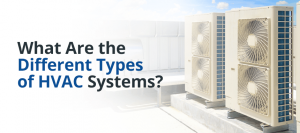 The Different Types Of HVAC Systems
The Different Types Of HVAC Systems
Whether you’re building a new home or replacing an old system, it’s essential to understand the different types of HVAC systems. This will help you choose the best system for your space and budget. Choosing the right system can save you money on energy bills, maintain air quality and improve the resale value of your property.
Split System
A split system is an air conditioning unit that consists of two separate components, a compressor and a condenser. The compressor is located outside your home and the condenser is located inside your home. The condenser converts refrigerant gas into a liquid and back again, which then absorbs and releases heat energy to cool or warm your indoor air. The compressor and the condenser operate in different ways depending on your climate. These types of HVAC systems are energy efficient and allow you to control temperature in individual rooms or zones. They also help reduce carbon emissions and improve indoor air quality. They also have lower installation costs and a smaller footprint on your property than ductless systems, which means you can save on both the cost of installing and maintaining the system. Additionally, a SEER rating for split systems is often twice as high as a package system, which means you can save on your monthly energy bills over the long term.
Hybrid System
If you’re looking for a way to improve your energy efficiency and save money, consider installing a hybrid system. They combine heating and cooling by using thermostats, ductwork and an electric furnace. This type of system can save homeowners a significant amount of money on their utility bills. It’s also more efficient than a traditional split system because it can switch between gas and electricity depending on your needs. Another benefit is that a hybrid system helps you keep technology refreshment simple. It allows you to combine your existing equipment with newer technologies and use buses or platforms that might otherwise be too expensive or limited for older systems. All and all, hybrid systems can help you achieve the perfect balance of performance, scalability and cost while extending your test system’s lifecycle. In addition, they can ease the transition to cloud solutions. This can free IT professionals up to focus on optimizing infrastructure, providing end-user support and developing new features.
Ductless System
Ductless systems are a great choice for a variety of applications. They offer flexibility, personalized comfort, energy savings, smartness and reduced carbon footprint. Ductless mini-splits, also known as ductless heat pumps, provide year-round heating and cooling by linking individual room units to an outdoor compressor. The indoor unit contains evaporator coils cooled with refrigerant that transfers the warm air from each room to the outdoor unit. They are incredibly energy efficient, and the average system uses 60% less electricity to cool one room than a centralized system with ductwork. These systems can be customized to operate for different rooms with a zoning control feature, which allows you to set the temperature of specific areas to your liking. These units are also very quiet, which is an excellent feature if you’re planning to use the AC while watching TV or listening to a music playlist. They are also extremely easy to install, and only require a small hole in the wall for piping.
Packaged Heating And Air
A packaged heating and air conditioning system is a single unit that contains all the essential components needed to heat and cool your home. It’s an ideal option for homes without crawlspaces or those with limited underground space. This type of HVAC system can also be configured with a natural gas furnace or electric heating coils. It also uses a single thermostat to control the operation of all units in one package, which gives you better control over the temperature of your home. These systems offer many benefits for homeowners, including ease of installation, space efficiency and lower maintenance costs. Plus, they’re energy efficient and quieter than split systems.
